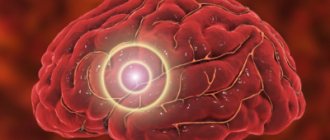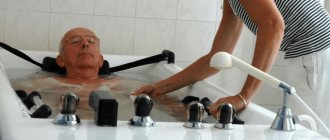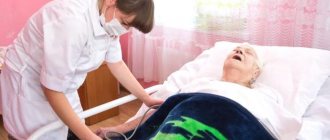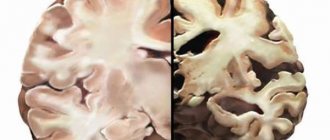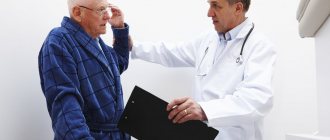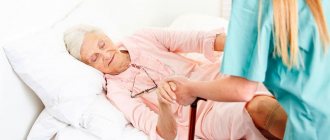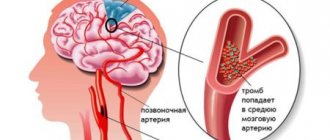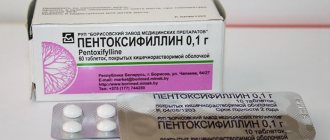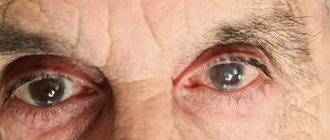What determines the speed of recovery?
According to research by the Scientific Center for Neurology of the Russian Academy of Medical Sciences, the timing and extent of the return of lost skills, as well as prognoses for future life, are directly related to the form of stroke suffered by the patient, the size of the lesion in the brain tissue, the age of the patient and the usefulness of the treatment provided to the victim. Rehabilitation after a stroke is never easy, since cerebrovascular accident always entails many different negative consequences that appear several years after the stroke.
The severity of a stroke affects recovery time
The recovery period can differ significantly from person to person in terms of timing and rate of return of skills. Patients who have suffered a major stroke experience serious disorders of the most important functions, so it will take a lot of time to regain lost skills, and even with the maximum implementation of the prescribed rehabilitation program, the prognosis is in most cases unfavorable. The greatest difficulties are associated with the full return of speech and motor function - relatives who devote a sufficient amount of time to special activities with the patient can help reduce the time.
In young people with a small lesion of the brain, in the absence of concomitant pathologies and careful adherence to medical instructions, the period of complete recovery passes quickly - it can take no more than two months, and the prognosis for a complete recovery will be favorable.
Treatment tactics
All patients with suspected stroke are hospitalized in a special department for the treatment of patients with stroke.
Patients with a disease duration of less than 6 hours are sent to the intensive care unit (neurointensive care unit). Patients with subarachnoid effusion are hospitalized in a specialized neurosurgical hospital. The treatment tactics for acute stroke during hospitalization have been determined:
- Monitoring and ensuring the functioning of vital functions (respiration, central hemodynamics).
- Controlling the level of oxygen supply to organs and tissues.
- Control of thermoregulation and basic parameters of homeostasis.
- Monitoring swallowing function, the condition of the bladder, intestines and skin.
- Measures to improve the hemodynamics of brain tissue.
- Measures aimed at protecting brain cells, improving blood properties and circulation.
- Treatment of associated disorders (cerebral edema, acute hydrocephalus, dislocation, hemorrhage in the infarction area).
When should classes start?
During a stroke, it is customary to distinguish periods that differ in clinical symptoms and the body’s susceptibility to therapeutic measures:
- The period of acute manifestations is the first day after the onset of the disease; the speed of first aid and the usefulness of the treatment directly affect the prognosis of the disease and the speed of recovery after a stroke.
- The acute period takes place during the first three weeks of the illness.
- Subacute period - from the third week to the third month after the stroke. It is during these periods that experts recommend starting simple exercises to restore motor skills - these can be passive exercises performed with the help of an assistant, or exercises for speech development. A special method is the positional treatment method: the patient’s limbs are placed in different positions to prevent the development of muscle hypertonicity. An important condition that accelerates the pace of rehabilitation is the timely administration of prescribed medications.
- The period of early recovery is from the third to the sixth month from the onset of the disease. This time is the most favorable for rehabilitation; classes during this period are considered the most productive. Treatment should never be delayed due to the high risk of slowing down the rate of recovery. The patient is prescribed an intense massage, active therapeutic exercise is added to passive exercises, and physiotherapy is performed. Most often, the patient is already discharged from the hospital during this period, so all activities are carried out on an outpatient basis.
- The period of late rehabilitation is the second half of the year from the onset of the disease; The body's potential for recovery gradually decreases, but remains sufficient to return lost skills.
- Long-term consequences - a year after a stroke, the rate of return of functions drops, recovery is delayed; exercises during this period give insignificant results.
The sooner restoration measures begin, the more effective they will be
How long does hospitalization last? On average, treatment in a hospital is carried out during the first month, and already at this time it is recommended to start classes - in this case, the likelihood of reducing rehabilitation time is maximum. The exercise program is always selected individually, based on the nature of the patient’s disorders; the prescribed tasks should be performed systematically over a long period, or more precisely, until the lost skills are completely returned. Many tasks are completed with some effort.
Stages of brain damage
Let's look at the different stages of brain damage and how long each period lasts. There are four stages of brain damage:
- Expansion of the non-functional area by 80% within 6 hours.
- Nucleation of brain cell necrosis occurs within 5-7 minutes after blood flow is blocked.
- The stage of spread of metabolic changes to neighboring tissues and the formation of a zone of non-functioning cells.
- Expanding the area of damaged but viable cells by half within 1.5 hours.
If timely medical assistance is not provided during the last stage, it will be impossible to rehabilitate already non-functioning cells. Therefore, it is so important not to miss the period when brain cells can still be restored to viability and to carry out intensive therapy.
Estimated terms of rehabilitation
As it becomes clear, the time frame for complete recovery is different for each patient. For some patients, a couple of months is enough, but in most cases, patients require a significant amount of time. It’s hard to say how long - sometimes the rehabilitation period stretches for several years.
The fundamental factor is the early start of measures to regain lost skills and the patient’s focus on results - without the patient’s internal desire to recover, the effect of the exercises will be low and the prognosis will be unfavorable.
Any treatment after a stroke should be carried out under the supervision of a specialist - only he can make changes to the rehabilitation program, regulate the level of physical activity and prescribe medications. The patient's recovery period does not end with discharge from the hospital. Performing prescribed exercise daily over a long period of time will help reduce the likelihood of having another attack of cerebrovascular accident.
First aid for cerebrovascular accident
After the first signs of an acute stroke appear, first aid must be provided:
- The very first task is to suspect that a stroke has occurred. If a person has unintelligible speech, distortion (paralysis) of the face, paralysis of the arm on the right or left, you should immediately sound the alarm (read about right-sided strokes here, and about left-sided strokes here).
- Without wasting time, call an ambulance. The call can be made from any landline or mobile phone by dialing 103.
- Provide the patient with a horizontal position, raising his head.
- If the patient is unconscious, you need to open his mouth slightly and tilt his head to the side. Be sure to monitor your breathing.
- Before the emergency team arrives, it is necessary to prepare information about the medications the patient is taking and those he cannot tolerate.
- Prepare the patient’s passport and medical documents.
- Tell the doctor all information about the patient.
- Accompany the patient.
Prognosis after a stroke
We can talk about prognoses for a future full life only after the acute period of the disease is over. Much depends on the form of the stroke - if there is a hemorrhagic type of circulatory disorder, the prognosis is more favorable and recovery will be faster. An ischemic stroke almost always entails more severe consequences, so favorable signs in this case are: the absence of severe speech impairment, cerebral symptoms, and the presence of movements in the limbs in the first three days after the stroke. Patients with these symptoms may experience full recovery within the first few months. In the case of falling into a coma on the first day after a cerebral infarction, unilateral loss of sensitivity, severe speech impairment and persistence of paralysis three months later, the prognosis for restoration of the ability to self-care is unfavorable. The absence of active movements in the limbs after six months or a year indicates a minimal likelihood of progress.
The prognosis for the restoration of motor skills after a stroke is directly proportional to the age of the patient - the older he is, the less likely he is to fully return to function and the longer the rehabilitation period. In many ways, how long recovery will take depends on the patient’s attitude towards a positive outcome and the desire to work on himself.
Symptoms and signs
Signs of stroke may appear suddenly or increase gradually. Symptoms of an acute stroke are:
- Strong headache;
- general weakness;
- nausea and vomiting;
- numbness in one half of the body;
- weakness in the arms or legs;
- disorientation;
- speech disorder;
- loss of consciousness.
Acute (up to 14 days)
The main danger in the acute period is cerebral edema. The swelling increases from the moment of the attack, reaching its highest point on days 2-5, and slowly subsides from 7-8 days. As a rule, the larger the size of the affected area of the brain, the more severe the swelling.
Therapy
All therapeutic efforts of medical personnel are aimed at relieving cerebral edema and preventing recurrent hemorrhage, leading to death.
Rehabilitation actions are added to the treatment efforts. The earlier rehabilitation of patients begins, the greater the likelihood of improving the restoration of lost functions. Exercise reduces the risk of complications and leads to a reduction in dosages of medications. But during the acute period, classes should not last more than 15-20 minutes.
Patient's well-being
Many patients at this time have limited movements, and short-term memory may be affected. Some have problems speaking and writing. For the first 2-3 weeks, the patient feels constant fatigue - the body is recovering from the crisis.
Consequences and complications
Complications may include:
- Paralysis or loss of muscle movement. Sometimes, lack of blood flow to the brain can cause paralysis on one side of the body or loss of control of certain muscles.
- Speech or swallowing problems. A stroke can cause loss of muscle control in the mouth, making it difficult to speak, swallow, and eat in general.
- Memory loss or difficulty understanding.
- If you have a stroke, you may experience pain, numbness, or other strange sensations in parts of your body. Sensitivity to temperature changes may occur.
- Changes in behavior and self-care. People may become withdrawn and less socially active.
- Complications from the cardiovascular system (edema, weakness).
- Epileptic seizures.
- Depression of mental functions (dementia).
